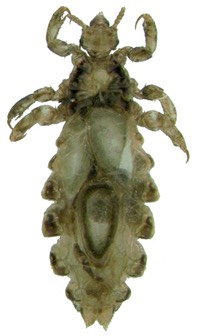The no-nits policies, variously drafted and adopted by school administrations, are supposedly designed to reduce the transmission of lice by excluding infested children from school. Whereas these policies may be meritorious in principle, they are virtually always counterproductive when applied. School nurses are generally amongst the most capable to spot signs of infestation, but often lack the expertise, time and equipment to distinguish active from inactive infestations. School personnel and parent volunteers often conduct mass-screenings in misguided and failed attempts to identify infested children and ensure their treatment. Concerned parents, nurses and school administrators may find it valuable to cooperate by helping to draft rational policies. The discovery of lice or their eggs on the hair should not cause the child to be sent home or isolated. Furthermore, treatment is not indicated if the infestation is not active.
Although lice and their eggs may be seen without the help of magnifying devices, the viability of the eggs cannot be judged without magnification and relevant training. Of thousands of samples of presumed lice and nits submitted to us for examination,fewer than half contained bona fide lice or louse eggs. Most samples were composed of miscellaneous insects or of artifacts that resembled eggs. Of those samples that did contain louse eggs, many were comprised solely of hatched or dead eggs; thus, no treatment would be warranted. We noted that: 1) health care professionals as well as non-specialists frequently over-diagnose this infestation, 2) non-infested children are quarantined as often as infested children, and 3) traditional pediculicides and ‘alternative’ formulations are frequently over-applied. Because pediculiasis is generally misdiagnosed, and because few symptoms and no direct infectious processes are know to result from an infestation, we have long suggested that the practice of excluding presumably infested children from school is unwarranted.
Although head lice are transmissible, their potential for epidemic spread is minimal. Indeed, the basic reproduction number (a measure that defines the number of secondary infections arising from an index case) would be far lower for head lice than for infections due to cold or flu viruses or even of pinworms - yet children are rarely excluded from school because of these often more-debilitating infections. Furthermore, we are unaware of any convincing data that demonstrate that enforced exclusion policies are effective in reducing the transmission of lice. It is our professional opinion that the no-nits policies are imprudent, as they are based on intolerance, hysteria and misinformation rather than on objective science.
Lice on children's heads, by themselves, should not be the cause for the schools or courts to brand the parents as 'neglectful' or 'abusive'. We are aware of several cases where the courts have ordered children removed from the custody of their parents because of their apparent failure to eliminate the infestations. Such extreme actions to an infestation are generally unwarranted and indicate a misunderstanding of the issues and/or poor judgment on the part of those making policy decisions. We are also aware of legal actions brought against the schools by the parents of children who have been excluded from school. These actions should now prompt school administrators to reevaluate their practices of identifying infestations as well as their exclusion policies and treatment recommendations.
To summarize the many arguments against the ‘no nit’ policies:
- there is no objective medical or scientific evidence to support the adoption, enforcement or continuation of a no-nits policy (or, for that matter, a 'no-live-lice' policy),
- the manner in which 'screenings' are conducted within schools may violate the confidentiality of the students,
- such screenings are often conducted by personnel who neither have certification as clinical laboratoratorians nor are medically qualified to render a medical diagnosis,
- the exclusion policies have never been demonstrated to reduce incidence or prevalence of head lice in the school population,
- the activity of screening within the school is burdensome to staff and students alike,
- the conclusions of the screeners are frequently flawed,
- the condition of pediculiasis rarely manifests with more than mild and transient pruritus, and is not associated with other infectious processes,
- head lice are acquired mainly by direct head-to-head contact with an infested person (rarely via inanimate objects),
- head louse eggs ('nits') are, for all practical considerations, non-transmissible,
- exclusion policies restrict educational opportunities for the affected students, and may (because of increased absentee rates) reduce state funding to schools,
- 'no-nit' as well as ‘no louse’ policies are discouraged by the American Academy of Pediatrics http://pediatrics.aappublications.org/cgi/reprint/peds.2010-1308v1.pdf The National Association of School Nurses http://www.nasn.org/Default.aspx?tabid=237), and by the US Centers for Disease Control and Prevention http://www.cdc.gov/lice/head/parents.html) also discourage the ‘no nit’ policies, and;
- certain prominent school systems have eliminated or modified their policies (e.g. New York City), and the feared 'epidemics' of lice have not materialized. See: http://schools.nyc.gov/Offices/Health/Pediculosis/default.htm
In addition to this discussion, interested readers are directed to a National PTA-commissioned article pertaining to the management of head lice in schools.

